Goodale Park
Goodale Park is a public park in the Victorian Village area of Columbus, Ohio. It was donated to the city in 1851 by Lincoln Goodale. For a few months during the Civil War, it was a staging area for Union troops known as Camp Jackson.[3] ComFest, a large, free, multi-day, non-corporate, music and arts annual festival, is held in the park in June.
| Goodale Park | |
|---|---|
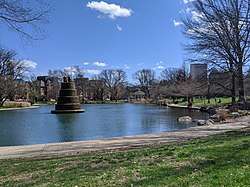 Pond and gazebo in Goodale Park | |
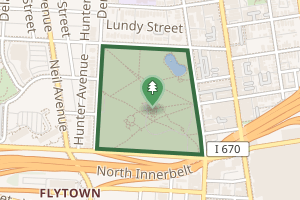
| |
| Type | Public |
| Location | Columbus, Ohio |
| Coordinates | 39°58′30.7″N 83°0′24.5″W |
| Area | 32.71 acres (13.24 ha)[1] |
| Elevation | 751 feet (229 m)[2] |
| Administered by | Columbus Recreation and Parks Department |
| Public transit access | |
| Website | goodalepark |
Located immediately north of downtown Columbus, the park is bordered by Goodale Street on the South, Park Street on the East, Buttles Avenue on the North, and Dennison Avenue on the West. Goodale Park features a pond, gazebo, tennis courts, a basketball court, bathrooms, and more.
Camp Jackson during the Civil War
From April to June 1861, the park was used as a staging area for new recruits for the Union Army. The camp started in April when Governor William Dennison, at the urging of President Lincoln, called on Ohio communities to revive their militias and send them to Columbus.
"A high picket fence is erected around the camp, and the curious public mills around all day. Few visitors are allowed in. There are reports that the troops eat very well while in the camp."
The Governor's Guards, a corps of soldiers stationed at the camp, marched through Columbus on a Saturday morning to urge the local people to show their patriotism and enlist in the cause. A Captain Morrow was particularly successful: his company grew so large from new recruits that he started a second company, and was nearly able to fill that one as well. "Any young man interested in enlisting in this company, "B" of the 3rd Regiment, is told to call at Camp Jackson at an early hour."
In June, Camp Jackson's military operations are transferred to Camp Chase, 4 miles (6.4 km) west of Columbus,[4] and Camp Jackson reverts to being a public park. During its peak, about 8,000 troops were stationed at the camp. Among the officers stationed at the camp were two future presidents: Rutherford B. Hayes and William McKinley.[3]
Gallery
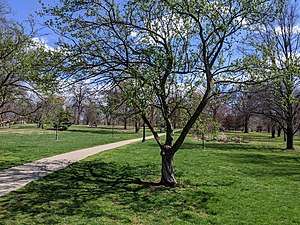 Grass lawns
Grass lawns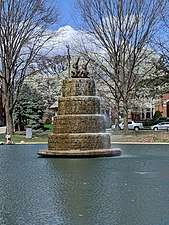 Fountain
Fountain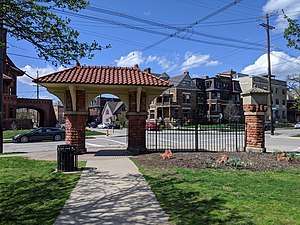 Arched entranceway
Arched entranceway
References
- "Facility: Goodale Park". Columbus Recreation & Parks Department. Retrieved February 22, 2012.
- "Goodale Park". Geographic Names Information System. United States Geological Survey. Retrieved February 22, 2012.
- Mullet Randall, Beverly (March 2007). "Dr. Lincoln Goodale and His Living Legacy Part Four: Goodale Park: A Brief History from the Beginning through the Civil War Years". Short North Gazette, Columbus, Ohio. Retrieved June 19, 2012.
- http://www.ohiohistorycentral.org/w/Camp_Chase?rec=662